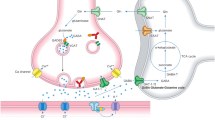Abstract
The metabotropic glutamate (mGlu) 1 receptor, coded by the GRM1 gene, is involved in synaptic activities, learning and neuroprotection. Eleven different mouse Grm1 mutations, either induced or spontaneously occurring, have been reported, including one from our group. All the mutations result in a complex phenotype with ataxia and intention tremor in mice. Moreover, autoantibodies against mGlu1 receptor have been associated with paraneoplastic cerebellar ataxia in humans. In spite of the large clinical and genetic heterogeneity displayed by the inherited forms of cerebellar ataxia, forms remain with a yet unknown molecular definition. With the evidence coming out from mouse models and from paraneoplastic ataxia, it seems that GRM1 represents a good candidate gene for early-onset ataxia forms, though no GRM1 mutations have thus far been looked for. The aim of this study was to investigate the possible involvement of GRM1 in early-onset or familial forms of ataxia. We searched for gene mutations in a panel of patients with early-onset ataxia as yet molecularly undefined. No causative mutations were found, though we detected synonymous variants in the exons and changes in flanking intronic sequences which are unlikely to alter correct splicing upon bioinformatics prediction. As for other known forms of inherited ataxias, absence of mutations in GRM1 seems to suggest a relatively low frequency in cerebellar ataxias.
Similar content being viewed by others
References
Aiba A, Kano M, Chen C, Stanton ME, Fox GD, Herrup K, Zwingman TA, Tonegawa S (1994) Deficient cerebellar long-term depression and impaired motor learning in mGluR1 mutant mice. Cell 79:377–388
Aiba A, Nakao H (2007) Conditional mutant mice using tetracycline-controlled gene expression system in the brain. Neurosci Res 58:113–117
Coesmans M, Smitt PA, Linden DJ, Shigemoto R, Hirano T, Yamakawa Y, van Alphen AM, Luo C, van der Geest JN, Kros JM, Gaillard CA, Frens MA, de Zeeuw CI (2003) Mechanisms underlying cerebellar motor deficits due to mGluR1-autoantibodies. Ann Neurol 53:325–336
Conti V, Aghaie A, Cilli M, Martin N, Caridi G, Musante L, Candiano G, Castagna M, Fairen A, Ravazzolo R, Guenet JL, Puliti A (2006) crv4, a mouse model for human ataxia associated with kyphoscoliosis caused by an mRNA splicing mutation of the metabotropic glutamate receptor 1 (Grm1). Int J Mol Med 18:593–600
De Michele G, Coppola G, Cocozza S, Filla A (2004) A pathogenetic classification of hereditary ataxias: is the time ripe? J Neurol 251:913–922
Downey PM, Petro R, Simon JS, Devlin D, Lozza G, Veltri A, Beltramo M, Bertorelli R, Reggiani A (2009) Identification of single nucleotide polymorphisms of the human metabotropic glutamate receptor 1 gene and pharmacological characterization of a P993S variant. Biochem Pharmacol 77:1246–1253
Ferraguti F, Crepaldi L, Nicoletti F (2008) Metabotropic glutamate 1 receptor: current concepts and perspectives. Pharmacol Rev 60:536–581
Ferraguti F, Shigemoto R (2006) Metabotropic glutamate receptors. Cell Tissue Res 326:483–504
Ichise T, Kano M, Hashimoto K, Yanagihara D, Nakao K, Shigemoto R, Katsuki M, Aiba A (2000) mGluR1 in cerebellar Purkinje cells essential for long-term depression, synapse elimination, and motor coordination. Science 288:1832–1835
Lim J, Hao T, Shaw C, Patel AJ, Szabo G, Rual JF, Fisk CJ, Li N, Smolyar A, Hill DE, Barabasi AL, Vidal M, Zoghbi HY (2006) A protein–protein interaction network for human inherited ataxias and disorders of Purkinje cell degeneration. Cell 125:801–814
Livak KJ, Schmittgen TD (2001) Analysis of relative gene expression data using real-time quantitative PCR and the 2(-Delta Delta C(T)) method. Methods 25:402–408
Mariotti C, Fancellu R, Di Donato S (2005) An overview of the patient with ataxia. J Neurol 252:511–518
Musante V, Neri E, Feligioni M, Puliti A, Pedrazzi M, Conti V, Usai C, Diaspro A, Ravazzolo R, Henley JM, Battaglia G, Pittaluga A (2008) Presynaptic mGlu1 and mGlu5 autoreceptors facilitate glutamate exocytosis from mouse cortical nerve endings. Neuropharmacology 55:474–482
Ng PC, Henikoff S (2003) SIFT: predicting amino acid changes that affect protein function. Nucleic Acids Res 31:3812–3814
Pan W (2008) Network-based model weighting to detect multiple loci influencing complex diseases. Hum Genet 124:225–234
Sasieni PD (1997) From genotypes to genes: doubling the sample size. Biometrics 53:1253–1261
Shutoh F, Katoh A, Kitazawa H, Aiba A, Itohara S, Nagao S (2002) Loss of adaptability of horizontal optokinetic response eye movements in mGluR1 knockout mice. Neurosci Res 42:141–145
Sillevis Smitt P, Kinoshita A, De Leeuw B, Moll W, Coesmans M, Jaarsma D, Henzen-Logmans S, Vecht C, De Zeeuw C, Sekiyama N, Nakanishi S, Shigemoto R (2000) Paraneoplastic cerebellar ataxia due to autoantibodies against a glutamate receptor. N Engl J Med 342:21–27
Stephens M, Scheet P (2005) Accounting for decay of linkage disequilibrium in haplotype inference and missing-data imputation. Am J Hum Genet 76:449–462
Stephens M, Smith NJ, Donnelly P (2001) A new statistical method for haplotype reconstruction from population data. Am J Hum Genet 68:978–989
Acknowledgments
This work was supported by grants from the Italian Ministero dell’Istruzione, dell’Università e della Ricerca Scientifica (Project n. 200728AA57_002) and from the Italian Ministry of Health, Strategic Program, RFPS-4-631972 “Genetic bases of Birth Defects”.
Author information
Authors and Affiliations
Corresponding author
Electronic supplementary material
Below is the link to the electronic supplementary material.
Rights and permissions
About this article
Cite this article
Rossi, P.I.A., Vaccari, C.M., Terracciano, A. et al. The metabotropic glutamate receptor 1, GRM1: evaluation as a candidate gene for inherited forms of cerebellar ataxia. J Neurol 257, 598–602 (2010). https://doi.org/10.1007/s00415-009-5380-3
Received:
Revised:
Accepted:
Published:
Issue Date:
DOI: https://doi.org/10.1007/s00415-009-5380-3




